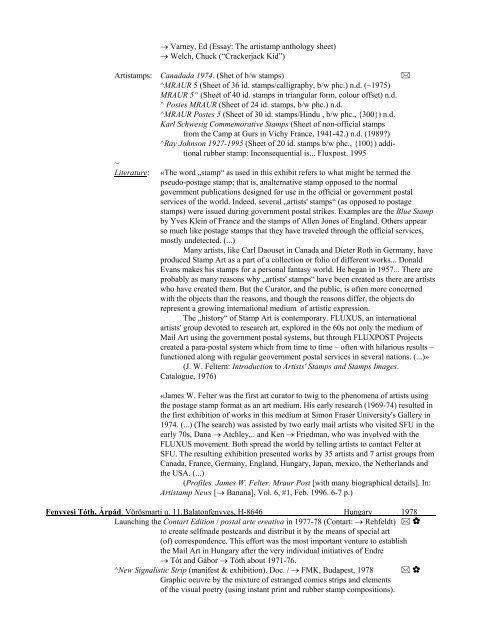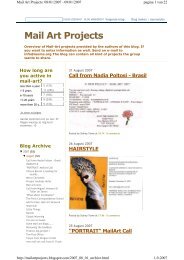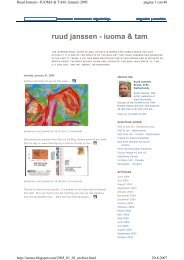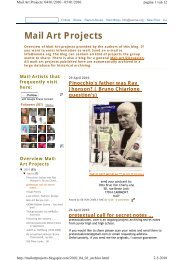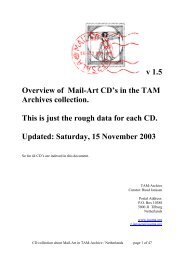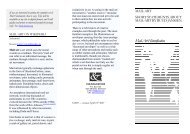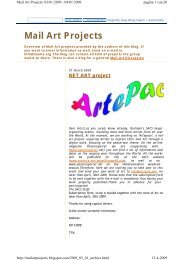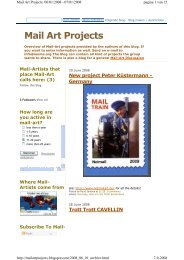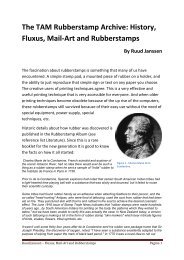Géza Perneczky - Ruud Janssen
Géza Perneczky - Ruud Janssen
Géza Perneczky - Ruud Janssen
You also want an ePaper? Increase the reach of your titles
YUMPU automatically turns print PDFs into web optimized ePapers that Google loves.
→ Varney, Ed (Essay: The artistamp anthology sheet)<br />
→ Welch, Chuck (“Crackerjack Kid”)<br />
Artistamps: Canadada 1974. (Shet of b/w stamps) <br />
^MRAUR 5 (Sheet of 36 id. stamps/calligraphy, b/w phc.) n.d. (~1975)<br />
MRAUR 5“ (Sheet of 40 id. stamps in triangular form, colour offset) n.d.<br />
^ Postes MRAUR (Sheet of 24 id. stamps, b/w phc.) n.d.<br />
^MRAUR Postes 5 (Sheet of 30 id. stamps/Hindu , b/w phc., {300}) n.d.<br />
Karl Schwesig Commemorative Stamps (Sheet of non-official stamps<br />
from the Camp at Gurs in Vichy France, 1941-42.) n.d. (1989?)<br />
^Ray Johnson 1927-1995 (Sheet of 20 id. stamps b/w phc., {100}) additional<br />
rubber stamp: Inconsequential is... Fluxpost. 1995<br />
~<br />
Literature:<br />
«The word „stamp“ as used in this exhibit refers to what might be termed the<br />
pseudo-postage stamp; that is, analternative stamp opposed to the normal<br />
government publications designed for use in the official or government postal<br />
services of the world. Indeed, several „artists' stamps“ (as opposed to postage<br />
stamps) were issued during government postal strikes. Examples are the Blue Stamp<br />
by Yves Klein of France and the stamps of Allen Jones of England. Others appear<br />
so much like postage stamps that they have traveled through the official services,<br />
mostly undetected. (...)<br />
Many artists, like Carl Daouset in Canada and Dieter Roth in Germany, have<br />
produced Stamp Art as a part of a collection or folio of different works... Donald<br />
Evans makes his stamps for a personal fantasy world. He began in 1957... There are<br />
probably as many reasons why „artists' stamps“ have been created as there are artists<br />
who have created them. But the Curator, and the public, is often more concerned<br />
with the objects than the reasons, and though the reasons differ, the objects do<br />
represent a growing international medium of artistic expression.<br />
The „history“ of Stamp Art is contemporary. FLUXUS, an international<br />
artists' group devoted to research art, explored in the 60s not only the medium of<br />
Mail Art using the government postal systems, but through FLUXPOST Projects<br />
created a para-postal system which from time to time – often with hilarious results –<br />
functioned along with regular geovernment postal services in several nations. (...)»<br />
(J. W. Feltern: Introduction to Artists' Stamps and Stamps Images.<br />
Catalogue, 1976)<br />
«James W. Felter was the first art curator to twig to the phenomena of artists using<br />
the postage stamp format as an art medium. His early research (1969-74) resulted in<br />
the first exhibition of works in this medium at Simon Fraser University's Gallery in<br />
1974. (...) (The search) was assisted by two early mail artists who visited SFU in the<br />
early 70s, Dana → Atchley,.. and Ken → Friedman, who was involved with the<br />
FLUXUS movement. Both spread the world by telling artists to contact Felter at<br />
SFU. The resulting exhibition presented works by 35 artists and 7 artist groups from<br />
Canada, France, Germany, England, Hungary, Japan, mexico, the Netherlands and<br />
the USA. (...)<br />
(Profiles. James W. Felter. Mraur Post [with many biographical details]. In:<br />
Artistamp News [→ Banana], Vol. 6, #1, Feb. 1996. 6-7 p.)<br />
Fenyvesi Tóth, Árpád. Vörösmarti u. 11. Balatonfenyves, H-8646 Hungary 1978<br />
Launching the Contart Edition / postal arte creativa in 1977-78 (Contart: → Rehfeldt) <br />
to create selfmade postcards and distribut it by the means of special art<br />
(of) correspondence. This effort was the most important venture to establish<br />
the Mail Art in Hungary after the very individual initiatives of Endre<br />
→ Tót and Gábor → Tóth about 1971-76.<br />
^New Signalistic Strip (manifest & exhibition). Doc. / → FMK, Budapest, 1978 <br />
Graphic oeuvre by the mixture of estranged comics strips and elements<br />
of the visual poetry (using instant print and rubber stamp compositions).


